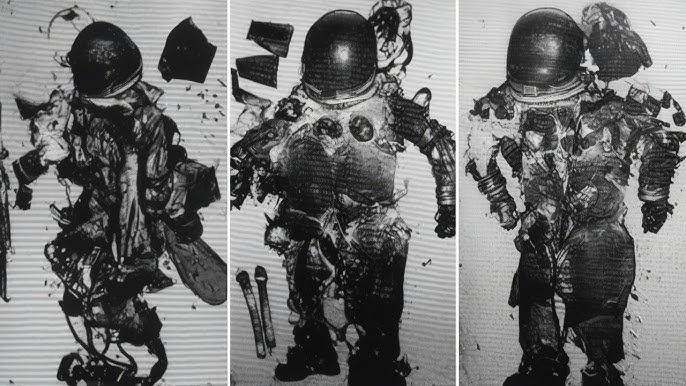The Apollo program promised to explore uncharted territory as it set out on its space exploration quest, but big goals also brought huge hurdles. An important part of this journey was the Apollo 1 mission, which was supposed to be the first crewed trip. The dangerous event occurred during a regular pre-flight test, changing the history of space travel forever.
Explore the compelling story of the Apollo 1 Bodies: Tragedy, a story of bravery, grief, & the enduring human spirit. Discover what caused the accident, what was looked into after, & how it continues to affect space travel while honouring the pioneers whose deaths made it possible for others to go to the stars in safety.
Apollo 1: Background and Mission Context

Image credit – Popular Science
The tragic events of Apollo 1 took place in the context of the vast Apollo program, which was an enormous US endeavour to accomplish crewed lunar exploration. Apollo 1 was intended to be the first crewed mission of the Apollo series. Its main goal was to carry out a number of pre-flight experiments, one of which was a crucial “plugs-out” test that simulated emergency situations on the launch pad.
With an emphasis on testing the spacecraft’s systems & guaranteeing crew safety in the harsh environment of space, the mission sought to prepare the way for further lunar missions. The catastrophic events that transpired on January 27, 1967, during the pre-flight test, brought the hazards & difficulties of space exploration to light & eventually shaped the Apollo program’s attitude to safety & mission planning.
Crew Members:

Image credit – Life.com
Three skilled astronauts who were involved in Apollo 1 bodies:
1. Virgil “Gus” Grissom:
- Astronaut for Mercury & Gemini.
- The second American in orbit.
- The first Gemini mission’s command pilot.
2. Edward H. White II:
- A Gemini astronaut
- The first American to carry out an extravehicular activity, or spacewalk, was part of Gemini 4.
3. Roger B. Chaffee:
- Appointed in 1963 as an astronaut.
- Appointed to go on Apollo 1 for his first space mission.
- Participated in the systems testing & spaceship design.
Pre-Flight Test and Tragedy:
The main motive of Apollo 1 pre flight test was to implement the launch pad emergencies with plugs out test. This occurred on 27th January, 1967, the test results in power cut in the spacecraft, so that the spacecraft’s capacity to function on internal systems. As soon as the astronauts Virgil “Gus” Grissom, Edward H. White II, & Roger B, were seated inside the spacecraft, fire ignited inside the craft in high range, which caused an immediate and most dangerous drawback. The spacecraft was completely destroyed by the fire, and also resulted in the death of all the crew.
Investigation and Findings:
- Comprehensive inquiry: To ascertain the underlying reasons of the tragic event, a thorough inquiry was initiated in the wake of the Apollo 1 catastrophe.
- Electrical Problems: The study determined that an electrical malfunction was most likely the cause of the ignition, highlighting the need of resolving technical issues with spacecraft systems.
- Combustible Materials: The command module’s interior included flammable materials, which increased the fire’s intensity & prompted a review of the materials used to build spacecraft.
- Oxygen-Rich Environment: It was determined that the oxygen-rich environment within the module had a crucial role in the fire’s quick spread, which led to modifications to the spacecraft’s atmosphere management & ventilation systems.
- Safety Protocol Revisions: The investigation’s conclusions led to a major reworking of safety procedures, highlighting the need for more stringent testing & improved fire safety precautions in missions to come.
- Design Enhancements: With an emphasis on reducing the likelihood of such events in future flights, lessons acquired from the inquiry inspired changes to spacecraft design, including adjustments to the materials utilised & advancements in electrical systems.
Impact on the Apollo Program:
The Apollo program was significantly impacted by the Apollo 1 disaster, which led to significant adjustments being made to spacecraft design & safety protocols. Because of the event, testing procedures were reexamined with a focus on crew safety. Considerable alterations were made, such as bettering the materials used in the building of the spaceship, strengthening fire safety protocols, & modifying the atmosphere control systems. Although the death of the Apollo 1 crew was a tragic event, astronaut safety has received more attention as a result of the lessons learnt from it.
Lessons Learned and Safety Improvements:
1. Thorough Testing Protocols: The Apollo 1 disaster made clear how important it is to have rigorous testing protocols, which led to a review of pre-flight operations to find & fix any possible problems before crewed flights.
2. Material Selection: The study brought attention to the importance of the materials used in the building of spacecraft. Changes in materials were used in later flights to reduce the danger of fire & enhance spaceship safety.
3. Atmosphere Control: The accident’s lessons highlighted how crucial it is to control the spacecraft’s atmosphere. In order to lower the danger of fire & provide a safer environment for astronauts, modifications were made to ventilation systems & atmospheric control procedures.
4. Improvements to the Electrical System: The investigation’s identification of an electrical failure led to upgrades to the spacecraft’s electrical systems, including better insulation & safety measures to avoid future occurrences of this kind.
5. Emergency Procedures: As a result of the disaster, all emergency protocols were thoroughly reviewed & updated to make sure that ground control & astronauts were better equipped to handle unforeseen circumstances. An emphasis was placed on quick & efficient evacuation in the event of an emergency.
Ongoing Impact on Space Exploration:
The Apollo 1 bodies accident has had a profound impact on space exploration & serves as a sobering reminder of the dangers that come with travelling beyond Earth. The knowledge gained from this regrettable incident has been crucial in forming modern space missions, encouraging a culture where safety is given first priority & crewed space missions undergo extensive testing. The sobering reality brought on by the death of the Apollo 1 crew is responsible for the dedication to painstaking spacecraft design, sophisticated safety procedures, & continuous technological breakthroughs.
Memorialization and Remembrance:

Image credit – The New York Times
The astronauts Virgil “Gus” Grissom, Edward H. White II, & Roger B. Chaffee, who were involved in Apollo 1 mission are remembered forever in NASA & Space research community. They are still remembered in many ceremonies, salutations & memorials, where their sacrifices & dedication towards the craft is praised & honored.
These astronauts are a symbol of inspiration for many upcoming generations & also they are a part of our history. The Apollo 1 crew were remembered with “Ex Ad Astra Per Aspera” which means Through Hardship to the Stars.
Their sacrifice have been a most important part of the mission & helped for later developments.
Conclusion
In conclusion, the Apollo 1 Bodies issue is considered as a darkest chapter in the history of space travel, serving as a reminder of dangerous events & sacrifices involved in humanity’s research for space. The tragic deaths of Edward H. White II, Roger B. Chaffee, & Virgil “Gus” Grissom marked a great change in spacecraft design, safety procedures, & testing methods.
Their legacy lives on in the monuments erected in their honour as well as in the safety improvements that are now standard equipment on journeys into orbit. The tragic events of Apollo 1 serve as a sobering reminder that knowledge & discovery need steadfast dedication to the safety of those who dare to go beyond our planet. Let us use the knowledge gained from Apollo 1 to our ongoing exploration of the cosmos & pay tribute to the courageous pioneers who cleared the path for humanity’s ascent to the skies.








